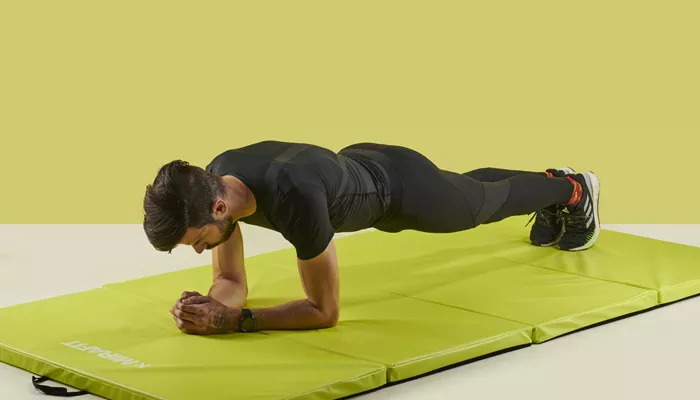Many people believe that achieving health and fitness goals requires spending long hours in the gym several times a week. However, this is not true for most individuals. Research shows that even small amounts of regular activity can make a difference.
A recent study published in the European Journal of Applied Physiology found that doing a five-minute strength training routine every day for four weeks significantly improved both physical fitness and mental health in people who were mostly inactive.
The workout itself was simple. It included basic bodyweight exercises: squats, press-ups, sit-ups, and calf raises. The key to its success was consistency and gradual increase in difficulty over time.
Though the study involved a small group, it clearly shows that brief strength training can bring many benefits, especially for beginners. I looked into why this works and how you can apply it to your own routine.
The Workout Routine
Participants in the study—22 adults aged 32 to 69 who were healthy but mostly sedentary—performed these exercises daily:
Chair squat x10
Wall press-up x10
Chair recline x10 (similar to a sit-up but done in a chair with less movement)
Heel drop x10 (calf raise)
Each repetition was done with a slow lowering phase lasting five seconds, followed by a quick lifting phase of about one second. For example, during the chair squat, participants would sit down slowly over five seconds, then stand up normally.
Participants could choose when to do their exercises, either all at once or spread throughout the day. When they could complete 10 reps of an exercise with moderate effort (rated 5 out of 10) for two days in a row, they moved on to a harder version of that exercise.
Progressions included:
Chair squat → one-leg chair squat → pistol squat
Wall press-up → one-arm wall press-up → table press-up → knee press-up → full press-up
Chair recline back → chair recline back with straight legs → sit-up
Heel drop → heel drop overstretch → one-leg heel drop overstretch
This approach is not a magic solution but is based on well-known strength training principles. The exercises target major muscle groups and use progressive overload to encourage positive change in beginners.
What This Means for Your Fitness
This article targets people who want to improve their health but find it hard to make time for exercise. Small, consistent activity like this can produce meaningful results.
Dr. Richard Blagrove, a physiology expert at Loughborough University, says that even very small amounts of exercise are beneficial, though more exercise offers greater benefits. He points to research showing that burning just 500 extra calories a week—about 70 calories a day—reduces the risk of death compared to no activity at all.
The same applies to resistance training. Even one challenging set can improve strength and daily physical function.
Fitness coach Joe Wicks has also observed this in his work visiting UK workplaces. He sees a clear difference between people who don’t exercise at all and those who find a few minutes for physical activity—like walking, lunchtime workouts, or short online sessions. Those who move more tend to be healthier, less stressed, and mentally sharper.
Wicks emphasizes making exercise manageable. “You might not have an hour today, but do you have five, 10, or 15 minutes? That makes a difference,” he says.
Other Easy Fitness Strategies
Exercise snacking—short bursts of activity spread through the day—is another effective way to stay active. A study from the University of Essex and University of Suffolk found that just 16 minutes of bodyweight exercises scattered across an eight-hour workday improved leg strength and balance in sedentary adults.
Research in Exercise and Sport Sciences Reviews describes exercise snacks as brief, vigorous efforts lasting less than 60 seconds, done multiple times daily. Activities like cycling or stair climbing three times a day can improve cardiovascular fitness and performance in inactive people.
The science behind these benefits is called the SAID principle: Specific Adaptations to Imposed Demands. This means the body improves in response to the demands we place on it. If you sit all day, your muscles may tighten. If you regularly raise your heart rate or do resistance exercises, your body will grow stronger and fitter.
New exercisers can see big improvements from small changes. Experienced athletes need bigger challenges to continue progressing.
Key Takeaways and a Beginner Workout Plan
The main message is simple: a little exercise goes a long way, especially for beginners.
The study shows that just a few minutes of daily bodyweight exercises can boost strength and mental health. Other research suggests these benefits also include better heart and lung fitness.
To start, choose one exercise for each basic human movement: push, pull, hinge, squat, and carry. Do each for 8-12 reps, one to three times a day. For example:
Push: Wall press-up x8-12
Pull: Bent-over row with a rucksack x8-12
Hinge: Good morning x8-12
Squat: Chair sit-to-stand x8-12
Carry: Suitcase carry with a rucksack, 8-12 meters each hand
You can do these after waking, on a lunch break, or even while boiling a kettle. When an exercise feels easy, try a harder variation or increase the weight.
This simple, no-equipment plan suits even the busiest people and helps build a healthier, stronger body over time.

